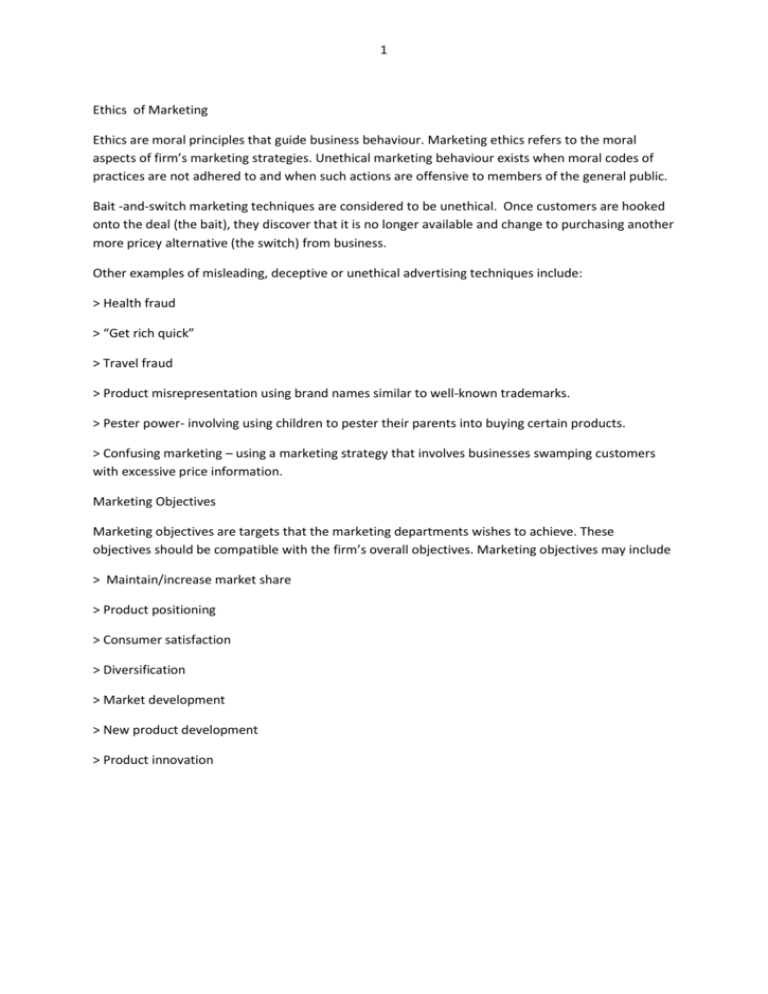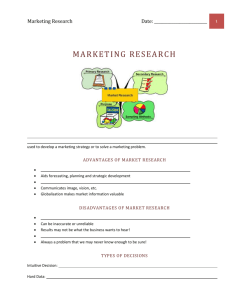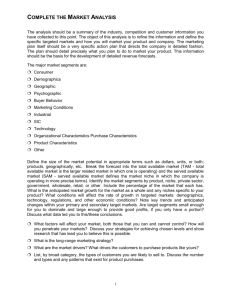Grade.11. Notes on Marketing
advertisement

1 Ethics of Marketing Ethics are moral principles that guide business behaviour. Marketing ethics refers to the moral aspects of firm’s marketing strategies. Unethical marketing behaviour exists when moral codes of practices are not adhered to and when such actions are offensive to members of the general public. Bait -and-switch marketing techniques are considered to be unethical. Once customers are hooked onto the deal (the bait), they discover that it is no longer available and change to purchasing another more pricey alternative (the switch) from business. Other examples of misleading, deceptive or unethical advertising techniques include: > Health fraud > “Get rich quick” > Travel fraud > Product misrepresentation using brand names similar to well-known trademarks. > Pester power- involving using children to pester their parents into buying certain products. > Confusing marketing – using a marketing strategy that involves businesses swamping customers with excessive price information. Marketing Objectives Marketing objectives are targets that the marketing departments wishes to achieve. These objectives should be compatible with the firm’s overall objectives. Marketing objectives may include > Maintain/increase market share > Product positioning > Consumer satisfaction > Diversification > Market development > New product development > Product innovation 2 SAMPLING Sampling is the practice of selecting a small group (or sample) of the population for a particular market for primary research purpose. Sampling methods: There are five main methods of sampling : quota, random, stratified, cluster and snowballing. 1. Quota sampling Quota sampling is based on market segmentation, i.e. grouping research respondents according to shared characteristic s such as their age, gender, or occupation. It is most commonly used sampling method in market research. 2. Random sampling Random sampling also know as probability sampling, involves, giving everyone in the population an equal chance of being selected for the sample. The respondents are often randomly chosen by a computer using information from a database. Airlines might use this method to get feedback from its business and first-class passengers. 3. Stratified sampling Stratified sampling is similar to quota sampling in that it involves segmentation. The population is likely to be heterogeneous so needs to be subdivide into segments (known as strata) that share homogeneous or very similar characteristics. This method benefits from using samples that are more representative of a particular market segment. 4. Cluster Cluster sampling is used when getting feedback from respondents involves too much time, travelling or money. For instance, it would be too time consuming and costly for a multinational to randomly interview people across all the countries that it operates in, instead, it is more cost effective to select several geographical areas (known as clusters) and then randomly interview people within each of the chosen clusters. 5. Snowballing Snowballing refers to surveys or interview carried out with individuals who then suggest other friends, family or colleagues to increase the sample. Businesses use this technique when they are unable to get hold of appropriate respondents since the population is not clear. Snowballing is common in the financial services such as health insurance, motor vehicle insurance and personal financial planning. 3 MARKET SEGMENTATION AND CONSUMER PROFILES Market segmentation – is the process of splitting a market into distinct groups of buyers in order to better meet their needs. The main method of market segmentation is based on demographics, geographic and psychographics factors. Targeting – means that each distinctive market segment can have its own marketing mix. Different markets can also be targeted, depending on whether they operate in niche, differentiated or mass markets. Consumer profile – are the characteristics of customers and consumers in different markets, such as their age, gender, income and purchasing habits. Segmentation by demographics. Demography is the study of the characteristics of the human population within certain areas or region. It looks at a range of variable including: Age Gender Race and ethnicity Marital status Religion Language Income and socio-economic class Segmentation by geographic factors Location Climate Segmentation by psychographic factors Status Values Culture Hobbies and interests Advantages of segmentation - Better understanding of customers Increase sales Growth opportunities Gives support to product differentiation 4 It is not always be possible for a business to effectively carry out market segmentation. Marketers often use the acronym DAMAS as a set of criteria for ensuring successful segmentation: Differential – segments must be unique and respond to the different marketing mixes of the business. Actionable – businesses must be able to provide suitable products to cater for each segment. Measurable – the size and purchasing power of each segment must be quantifiable. Accessible – the business must be able to reach customers in customers in a costeffective way. Substantial – each market segment must be sufficiently large in order to generate profits. 5 TARGETING Targeting means that each distinctive market segment can have its own marketing mix. Different markets can also be targeted, depending on whether they operate in niche, differentiated or mass markets. Niche marketing Niche marketing, also know as concentration marketing, targets a specific and well-defined market segment. Examples : Businesses that provide speciality goods such as Armani suits, Ferrari cars and Cartier watches operate in niche markets, catering for consumers interested in high-end luxury goods. Advantages of niche marketing: There is better marketing focus since a specific market segment is being targeted. Since there is less competition, businesses can charge higher prices for their exclusive products. This will help the business to gain higher profit margins. Firms become highly specialized in meeting the need and wants of their niche target market. Disadvantages of niche marketing: Limited number of customers Few opportunities to exploit economies of scale. Highly successful and profitable niche markets may attract new entrants into the industry. Undifferentiated marketing (mass marketing) Undifferentiated marketing, also know as mass marketing or market aggregation, is the strategy that ignores targeting individual market segments. Instead a large number of different market segments are targeted in order to maximize sales volume. Example : Coca-Cola, Nike, Nokia, Apple and Microsoft all use this strategy to all market segments in the same way. Advantages Huge potential economies of scale from being able to supply products in a mass market. 6 There is no need to tailor different marketing mixes for different segments, this can save the business a lot of time and resources. Disadvantages Competition can become quite fierce as customers must be persuaded to buy the firm’s product rather than to buy from a rival business. Mass marketing is not suitable for all businesses because there are high entry barriers for mass production. Differentiated marketing Differentiated marketing, also know as selective marketing or multi-segment marketing, is the targeting strategy that tailors a marketing mix to each market segment. Advantages Customers can enjoy a more satisfying experience since a tailored marketing mix caters for their specific and individual needs and wants. Risks are spread out by focusing on several market segments. Hence decline in one market segment has less of an impact on the overall business. Disadvantages Differentiated marketing is costly. Excessive differentiation can drain a firm’s resources and confuse customers. (In reality, many businesses will have operations that use all three targeting Strategies) 7 POSITIONING Market positioning is analytical tool that ranks different products, services or firms in relation to others in the market according to the views of the general public. Example : most customers perceive Evian and Perrier as superior brands of bottled water. There are three stages of positioning: Identify the competitive advantages of the product. Decide in which aspects of these strengths should be marketed. Implement the desired positioning by using an appropriate marketing mix. Corporate image Corporate image plays a vital part in the success of businesses. There are vast possibilities for a firm to improve its corporate image, such as through implementation of corporate social responsibilities (CSR). Some CSR activities include providing educational support for schools, colleges and universities. Firms might also sponsor environmental projects to enhance their corporate image. A poor image will not only drive customers away, but it can also impose damage that is irrevocable. Example : In 2007, Pakistan International Airlines was banned from flying European Union countries due to safety concerns. In the same year, America also raised concerns over the poor image of Garuda Airways, the Indonesian airline carrier, due to its poor safety record. Unique selling point (USP) Unique selling point or unique selling proposition, refers to any aspect of a product that makes it stand our from those offered by rival businesses. The USP explains why customers buy the product over rival brands. A USP can be major source of competitive advantage and therefore firms will want to emphasize their product’s USP in order to attract customers. This again can help develop firm’s image to differentiate itself from competitors.








